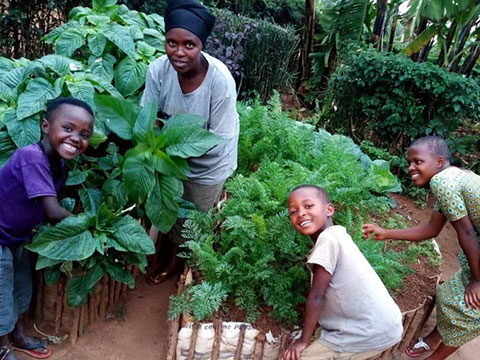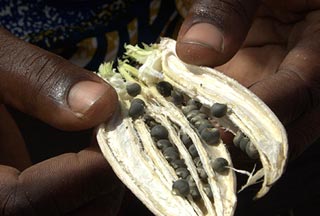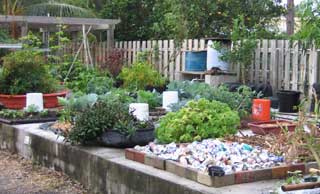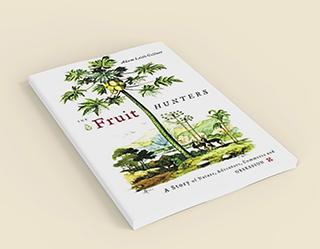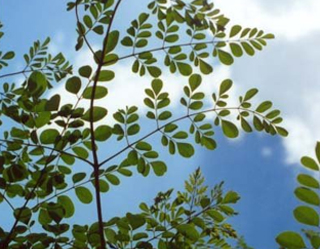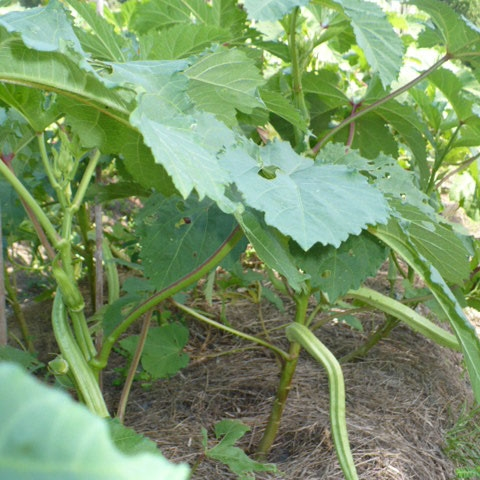Okra, Abelmoschus esculentus (a.k.a. gumbo), and Eggplant, Solanum melongena, well-known vegetables to most Americans, will grow well planted spring or summer in SW Florida. Both can be harmed by root knot nematodes. The pods of two okra varieties, ‘Borneo’ and ‘African’, can be eaten at a much larger size than most standard okra varieties. These two varieties both out-produce most other okra varieties in the late summer planting at ECHO while other varieties do better in earlier plantings
Eggplants come in many colors, shapes and sizes, from large, melon-sized to those that are egg-sized to those that are pea-sized. Their cheerful color variations make an appetizing addition to a fresh vegetable platter, soups, stir-fries, casseroles and other dishes.
Both okra and eggplant are propagated by seed. Seed available at ECHO Nursery
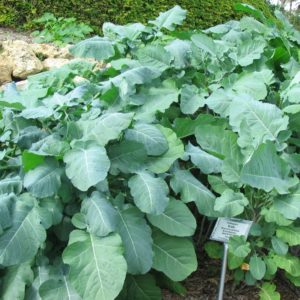
Ethiopian Kale, Brassica carinata
Ethiopian Kale, Brassica carinata (a.k.a. Abyssinian cabbage) is an annual cole crop which originates in the East African Plateau. It tolerates high temperatures and high humidity, setting seed where other kale varieties will not. Young tender leaves and stem tips of Ethiopian kale may be eaten fresh in salads or cooked. Older leaves and stems may be cooked and eaten like collards. Flower stalks may be cooked and eaten like broccoli. It can also be used as a fodder crop species for animals. Ethiopian kale is reproduced by seed and it is easy to designate an area in the garden for constant production of this prolific, nutritious leafy vegetable. Seed available at ECHO Nursery
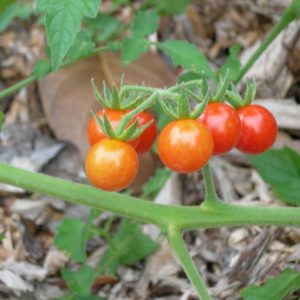
Cherry Tomatoes, Lycopersicon esculentum
Cherry Tomatoes, Lycopersicon esculentum var. cerasiforme, can produce during summer months, however, only varieties that are resistant to nematodes should be tried at any time. The package or at least a catalog description should indicate which diseases the variety is resistant to by using letters (V=verticilium wilt; N=nematode; F=Fusarium wilt; T=tobacco mosaic virus, among others). Even tomato vines that do well may not set fruit because of pollination problems during the warm season. Daytime temperatures must be under 90 F and nighttime temperatures under 70 to set fruit. Other than cherry tomatoes, romas, grape and salad tomatoes will also produce during the summer months. Tomatoes are propagated mainly by seed, but some have successfully propagated them by cuttings. Seed available at ECHO Nursery
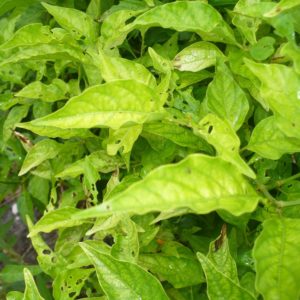
Hot peppers, Capsicum annuum
Hot peppers, Capsicum annuum, C. frutescens, C. chinense, and C. pubescens, can be grown as annuals, but they are actually perennials, and in countries where it does not freeze they can grow for several years. The variety ‘Indian firecracker’ is particularly striking when used in a container garden. The small red and green peppers make the plant look like it is decorated for Christmas. The larger “sweet peppers” are annuals and usually do not do well in the summer. Plant and seed available at ECHO Nursery
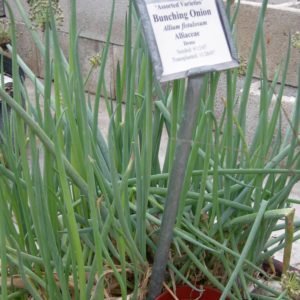
Bunching onions, Allium fistulosum
Bunching onions, Allium fistulosum, (a.k.a. Welsh onions) keep dividing, forming bunches that can be cut and used like green salad onions. These perennials may be propagated by divisions or by seed.
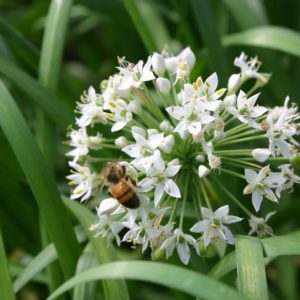
Garlic Chives, Allium tuberosum
Garlic Chives, Allium tuberosum (a.k.a. Chinese chives) make a great grass-like border or container plant, thriving through all seasons here in Florida. They are a great addition to an herb garden or as a border. Growing best in moist soils, they are also drought resistant. They grow well in sun or partial shade. The white stems and green leaves are used like green onions or chives to add flavor to salads, sour cream, stir fries, omelets and soups. They also make delicious herb butter and are popular in Asian cooking. They are perennial and should live for years, with clumps growing larger each year. Garlic Chives do not form a bulb. Most varieties have a bad reputation of producing a lot of seeds that can spread into the lawn. But ECHO was given a start of a variety being grown by a Japanese lady in the local rare fruit club. It almost never blooms in southwest Florida and hence does not become weedy. Harvest by cutting off at ground level. DO NOT DIG UP THE ROOTS WHEN YOU HARVEST! If you leave the roots they become very dense and the edible part will grow back in 3-4 weeks. Garlic chives are perennial and are propagated by seed or division. Plants propagated by seed will themselves produce seed and may become weedy.
“Garlic Chives make a great grass-like border or container plant, thriving through all seasons here in Florida. ”
If you want color, a plant with similar looking leaves called society garlic produces attractive purple flowers (and seeds). It also has a garlicy taste, but not nearly as subtle a taste as garlic chives. Plant available at ECHO Nursery

Wax gourd, Benincasa hispida
Wax gourd, Benincasa hispida, will grow best in the hot but dry late spring, but might produce into the summer months. It is sometimes called “Chinese winter melon,” and is popular in Asian markets and cuisine. The white flesh of the melon-like fruit is cooked in soups. The fruit is covered with an attractive white waxy “bloom” that protects it from microbial and insect attack and from drying out. Consequently, it stores exceptionally well. As with other plants in the cucurbit or cucumber family, the young shoots and flowers of the wax gourd may also be eaten in soups, in stir-fries or cooked and eaten as greens.
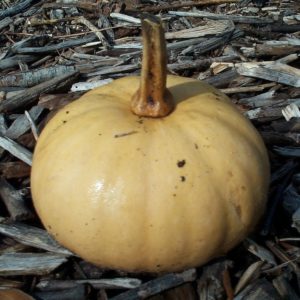
Tropical pumpkins, Cucurbita moschata
Tropical pumpkins, Cucurbita moschata, are one of the same species of squash grown in temperate climates although these have been selected for production in the tropics. Latin markets will likely have ‘Calabaza,’ which is the same species. They can be very productive any time except during the coldest weather. Tropical pumpkins can be used the same as the temperate pumpkin, but it can also be baked just like a winter squash or cooked when it is small and green and used like a summer squash. Additionally, the flowers and young shoots may be cooked and eaten as greens or stir-fry.
The pumpkin leaves can be damaged severely and quickly by a small caterpillar. See “vegetable amaranth” for a discussion of how to control it. The vigorous vines will grow along the ground and send out new roots, so planting near an area where it can sprawl is ideal. A few months later you might find the vine dead where you planted it but the new portion thriving many feet away. This may help the roots avoid nematodes. Seed available at ECHO Nursery
